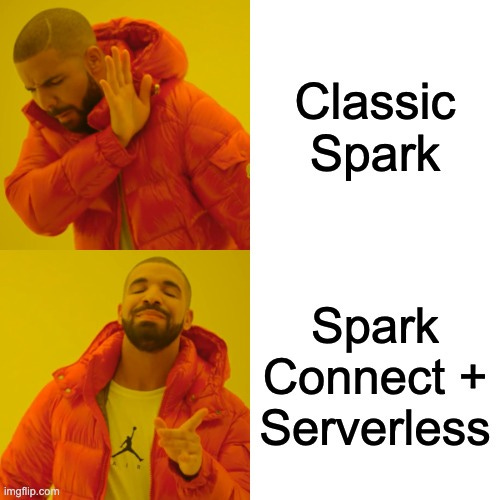How to use Spark Connect from Databricks Serverless?
Ever tried to run a quick Spark job, only to end up wrestling with cluster configs and driver logs? Been there, done that, got the "cluster headache" T-shirt.
But recently, I discovered a much smoother way: Spark Connect + Databricks Serverless. It's like going from assembling IKEA furniture to just clicking "order now" on your favorite app.
1. What is Spark Connect? How is it Different from Classic Spark?
Let's keep it real: Classic Spark means your code (the driver) lives on the cluster. You have to manage clusters, drivers, and all the jazz. It's powerful, but not always fun.
Spark Connect flips the script:
Your code runs on your laptop (the client)
Only the heavy lifting happens on the server
You connect via a lightweight protocol (like `sc://`), so you don't need to babysit clusters
In short:
Classic Spark: "I manage everything."
Spark Connect: "I just connect and go."
2. Example: Connect to Databricks Serverless (Try it Yourself!)
I put together a hands-on example you can run in minutes—no cluster wrangling required!
👉 https://github.com/hoaihuongbk/spark-connect-example
What's inside?
Step-by-step setup
Python code to connect, create a DataFrame, write to a Databricks table, run a SQL query, and clean up
Makefile for easy setup
Quick start:
git clone https://github.com/hoaihuongbk/spark-connect-example.git
cd spark-connect-example
make venv
make runYou'll need Python 3.10+, Databricks CLI, and access to a Databricks workspace with serverless SQL warehouse or cluster (e.g Databricks Free Edition). Full details are in the repo's README.
3. Why Spark Connect + Databricks Serverless is a Game Changer
When it comes to analytics and data exploration, speed and reliability are everything. You want answers fast, and you don't want to waste time setting up compute or waiting for clusters to start.
Here's why this combo shines for analytics and exploration:
Zero Compute Setup: No more fiddling with cluster configs or waiting for resources. Just connect and go—your compute is ready in seconds.
Blazing Fast Start: Databricks Serverless spins up clusters almost instantly, so you can jump straight into your analysis without delay.
Rock-Solid Reliability: The managed serverless backend means you get consistent performance and stability, even for ad hoc or unpredictable workloads.
Decoupled Architecture: Spark Connect lets you run Spark code from anywhere—your laptop, a web app, or even a notebook in the cloud. Upgrade or change your client without worrying about the backend.
Perfect for Exploration & Ad Hoc Analytics: Need to quickly check a dataset, prototype a transformation, or run some SQL? This combo is built for those "I just want to try something" moments—no waiting, no cluster wrangling.
4. Key takeaway
With Spark Connect and Databricks Serverless, running distributed data jobs is as easy as running local scripts. No more cluster wrangling!
If you found this helpful or have questions, drop a comment or share with a friend who's still fighting with clusters. 🚀
-----------------
🍜 Still here? You must really like this stuff – I appreciate it!
If you enjoyed this post, come grab another tech bite with CodeCookCash:
▶️ YouTube: youtube.com/@codecookcash
📝 Blog: codecookcash.substack.com
👋 Want more behind-the-scenes and tech-life reflections?
Connect with Huong Vuong:
💼 LinkedIn: linkedin.com/in/hoaihuongbk
📘 Facebook: facebook.com/hoaihuongbk
💡 Follow for fun – read for depth – learn at your pace.



